Strategic Marketing Plan for Samsung Galaxy A7 (2018) in Malaysia
VerifiedAdded on 2023/05/29
|17
|3786
|324
Report
AI Summary
This marketing plan outlines the strategy for launching the Samsung Galaxy A7 (2018) in Malaysia. It begins by introducing Samsung and the Galaxy A7, highlighting its key features such as the triple rear camera setup. The plan identifies the target market as mid-range phone users in Malaysia, leveraging psychographic segmentation due to the lifestyle-oriented nature of smartphone purchases. The marketing mix (product, price, place, promotion) is detailed, with a focus on competitive pricing and online advertising due to high internet penetration in Malaysia. The plan also considers environmental variables, including technological advancements, competitive landscape, and economic factors. It concludes by addressing the product lifecycle and its impact on the marketing mix, aiming to establish a strong market presence for the Samsung Galaxy A7 in Malaysia. Desklib provides access to similar marketing plans and solved assignments for students.
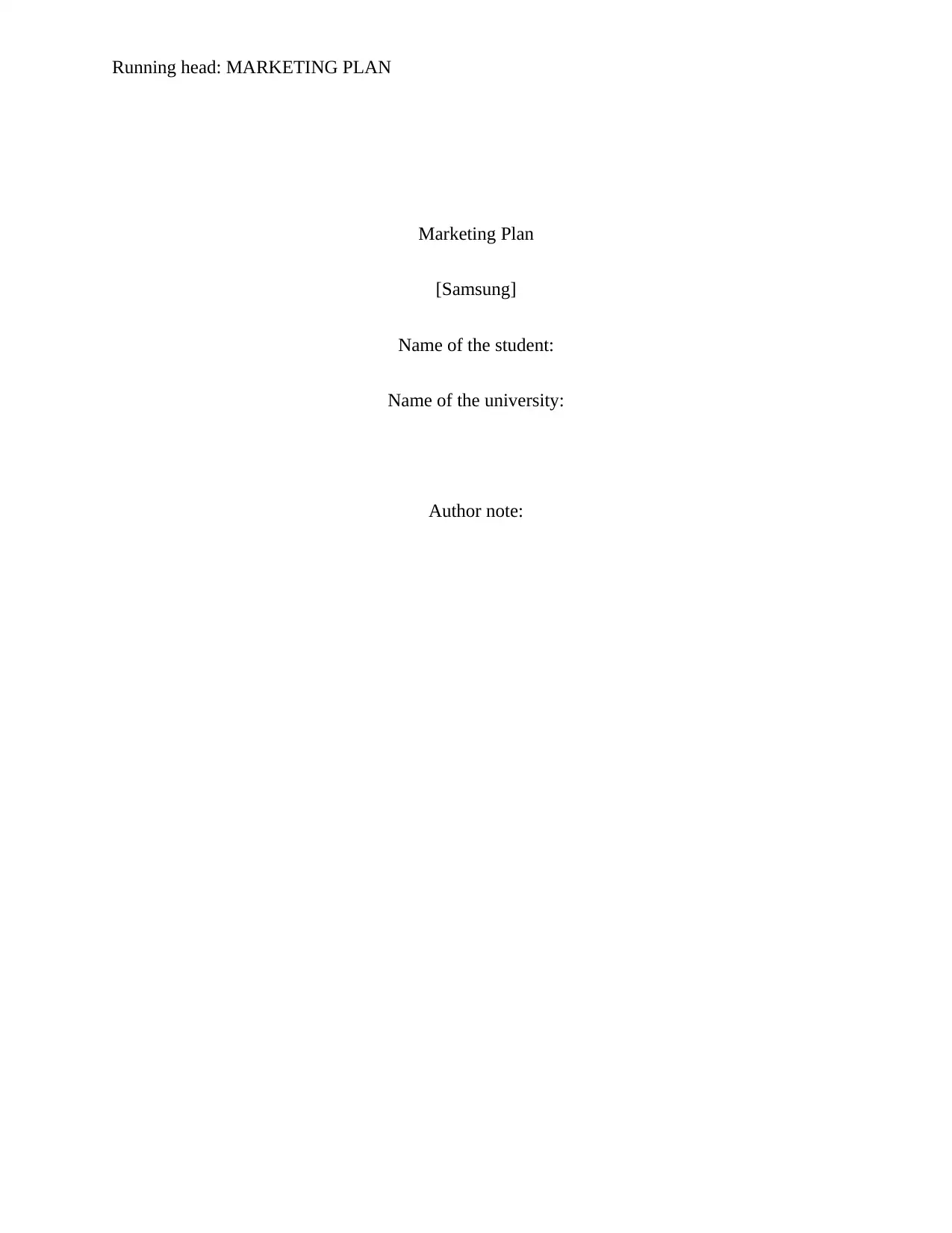
Running head: MARKETING PLAN
Marketing Plan
[Samsung]
Name of the student:
Name of the university:
Author note:
Marketing Plan
[Samsung]
Name of the student:
Name of the university:
Author note:
Paraphrase This Document
Need a fresh take? Get an instant paraphrase of this document with our AI Paraphraser
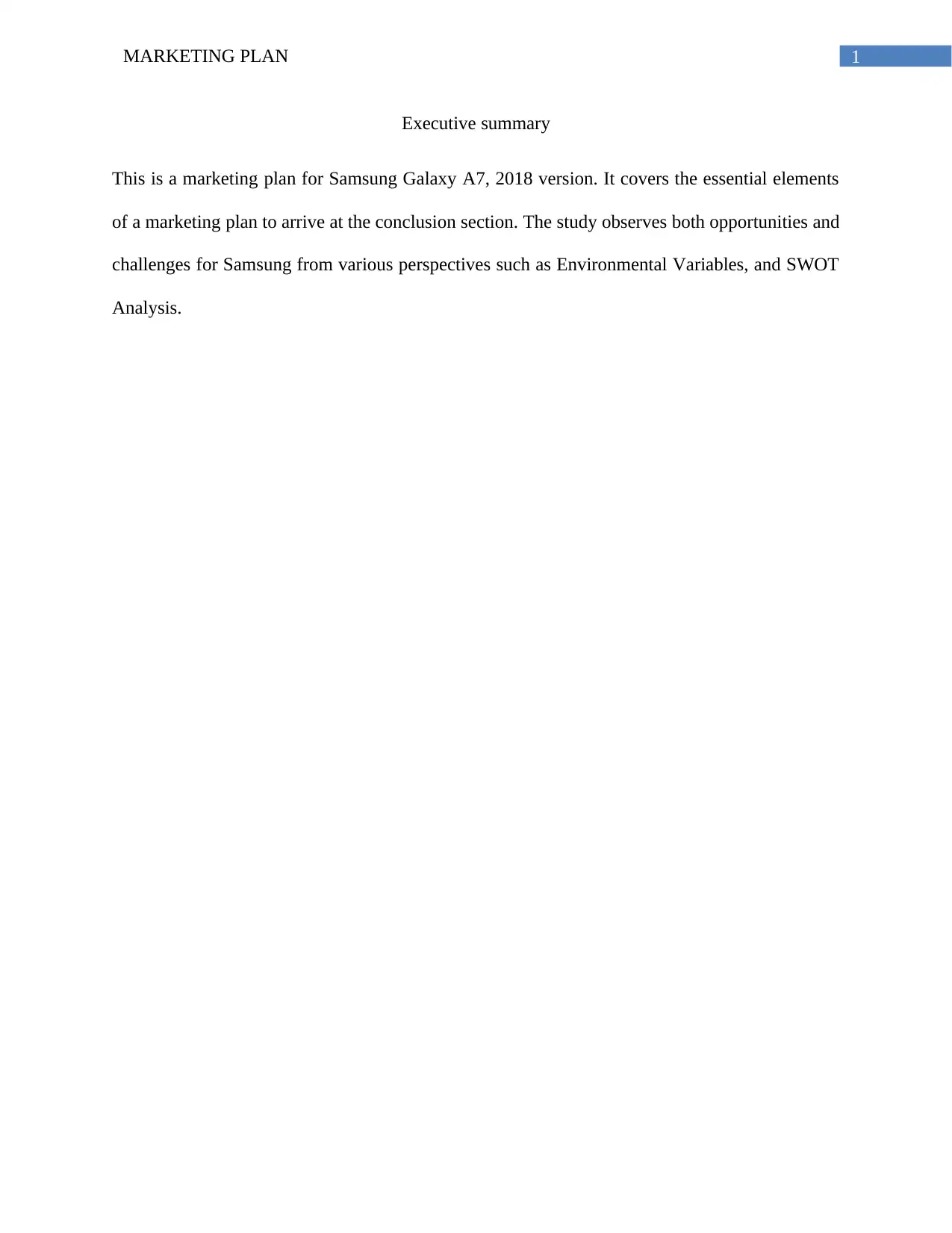
1MARKETING PLAN
Executive summary
This is a marketing plan for Samsung Galaxy A7, 2018 version. It covers the essential elements
of a marketing plan to arrive at the conclusion section. The study observes both opportunities and
challenges for Samsung from various perspectives such as Environmental Variables, and SWOT
Analysis.
Executive summary
This is a marketing plan for Samsung Galaxy A7, 2018 version. It covers the essential elements
of a marketing plan to arrive at the conclusion section. The study observes both opportunities and
challenges for Samsung from various perspectives such as Environmental Variables, and SWOT
Analysis.
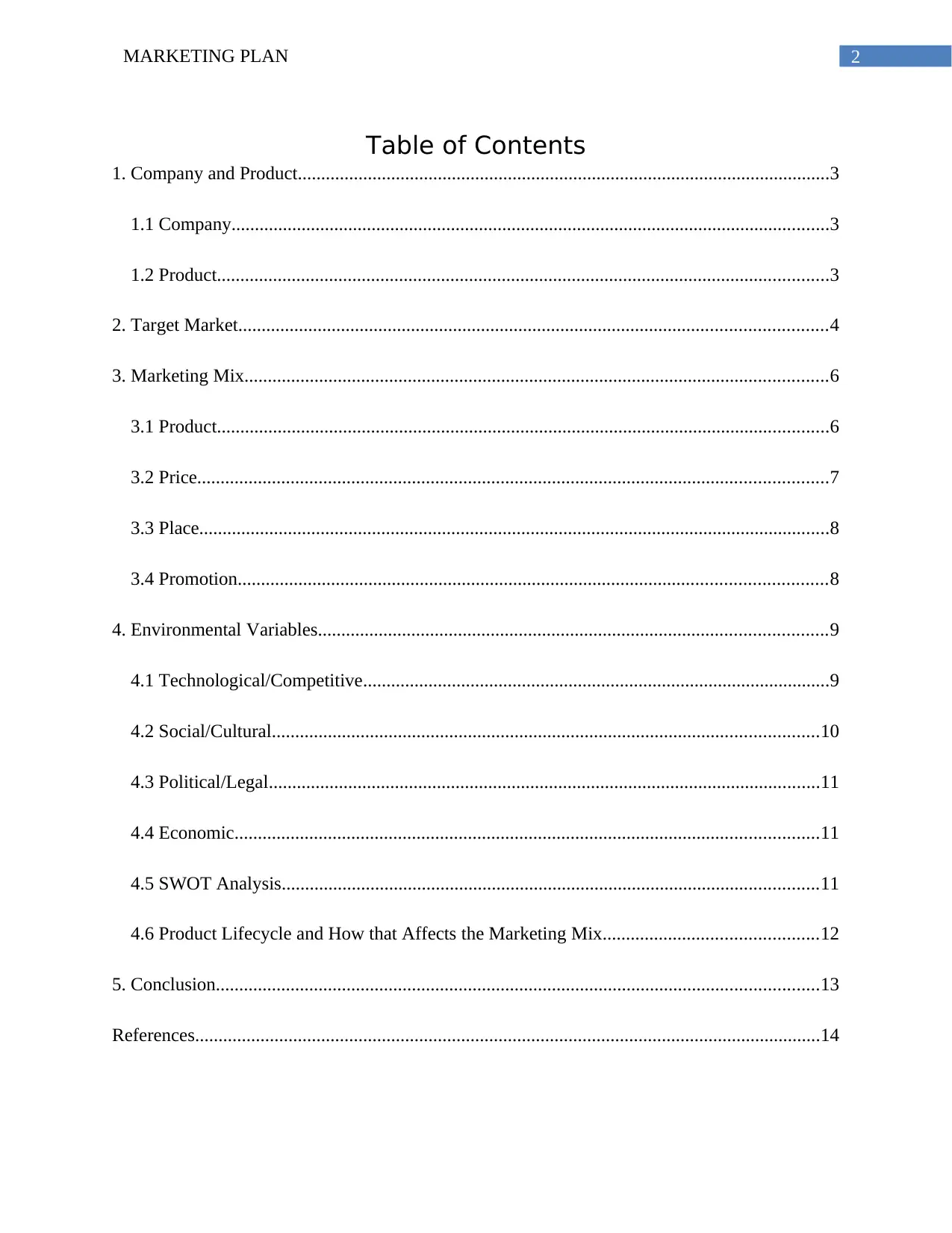
2MARKETING PLAN
Table of Contents
1. Company and Product..................................................................................................................3
1.1 Company................................................................................................................................3
1.2 Product...................................................................................................................................3
2. Target Market..............................................................................................................................4
3. Marketing Mix.............................................................................................................................6
3.1 Product...................................................................................................................................6
3.2 Price.......................................................................................................................................7
3.3 Place.......................................................................................................................................8
3.4 Promotion..............................................................................................................................8
4. Environmental Variables.............................................................................................................9
4.1 Technological/Competitive....................................................................................................9
4.2 Social/Cultural.....................................................................................................................10
4.3 Political/Legal......................................................................................................................11
4.4 Economic.............................................................................................................................11
4.5 SWOT Analysis...................................................................................................................11
4.6 Product Lifecycle and How that Affects the Marketing Mix..............................................12
5. Conclusion.................................................................................................................................13
References......................................................................................................................................14
Table of Contents
1. Company and Product..................................................................................................................3
1.1 Company................................................................................................................................3
1.2 Product...................................................................................................................................3
2. Target Market..............................................................................................................................4
3. Marketing Mix.............................................................................................................................6
3.1 Product...................................................................................................................................6
3.2 Price.......................................................................................................................................7
3.3 Place.......................................................................................................................................8
3.4 Promotion..............................................................................................................................8
4. Environmental Variables.............................................................................................................9
4.1 Technological/Competitive....................................................................................................9
4.2 Social/Cultural.....................................................................................................................10
4.3 Political/Legal......................................................................................................................11
4.4 Economic.............................................................................................................................11
4.5 SWOT Analysis...................................................................................................................11
4.6 Product Lifecycle and How that Affects the Marketing Mix..............................................12
5. Conclusion.................................................................................................................................13
References......................................................................................................................................14
⊘ This is a preview!⊘
Do you want full access?
Subscribe today to unlock all pages.

Trusted by 1+ million students worldwide
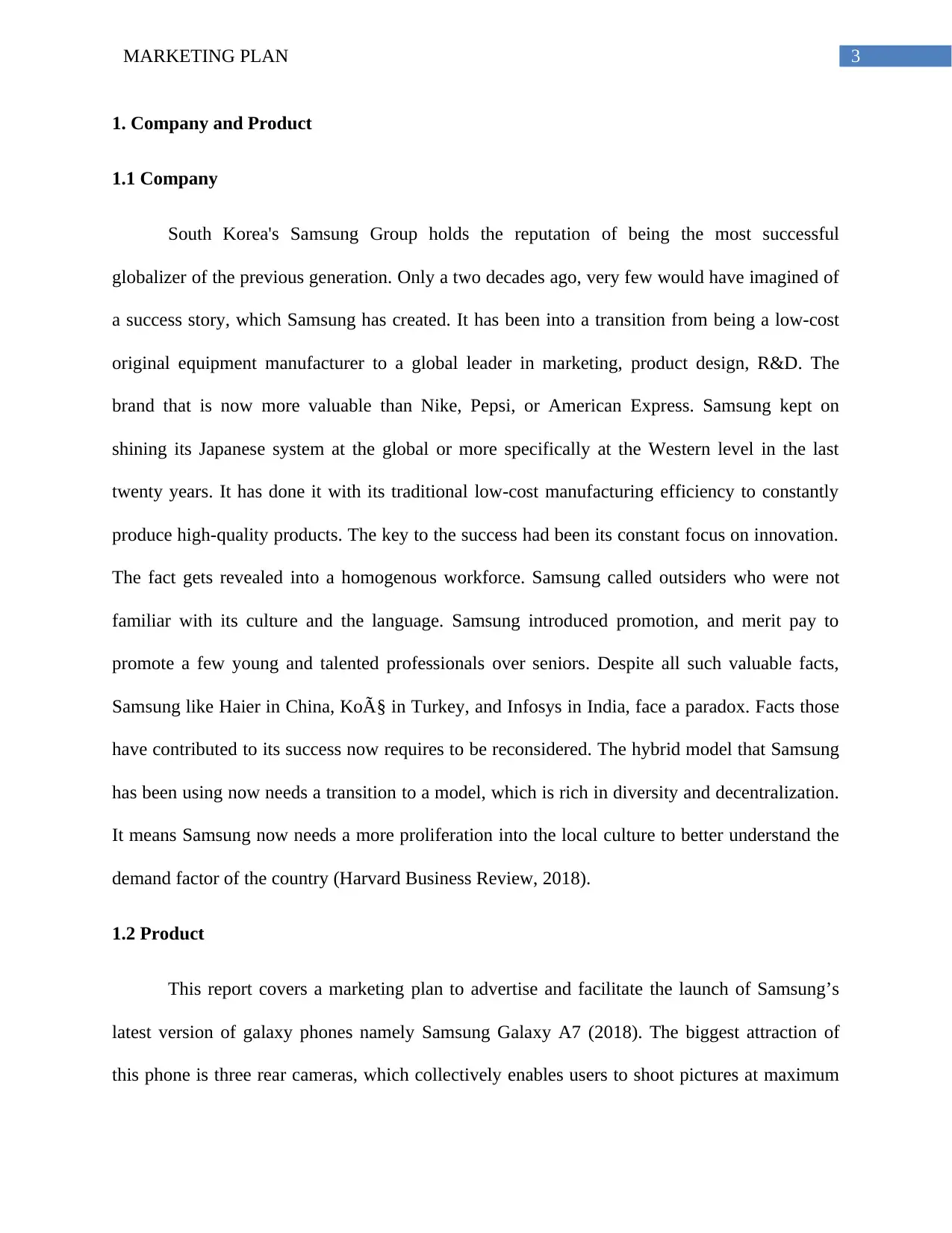
3MARKETING PLAN
1. Company and Product
1.1 Company
South Korea's Samsung Group holds the reputation of being the most successful
globalizer of the previous generation. Only a two decades ago, very few would have imagined of
a success story, which Samsung has created. It has been into a transition from being a low-cost
original equipment manufacturer to a global leader in marketing, product design, R&D. The
brand that is now more valuable than Nike, Pepsi, or American Express. Samsung kept on
shining its Japanese system at the global or more specifically at the Western level in the last
twenty years. It has done it with its traditional low-cost manufacturing efficiency to constantly
produce high-quality products. The key to the success had been its constant focus on innovation.
The fact gets revealed into a homogenous workforce. Samsung called outsiders who were not
familiar with its culture and the language. Samsung introduced promotion, and merit pay to
promote a few young and talented professionals over seniors. Despite all such valuable facts,
Samsung like Haier in China, Koç in Turkey, and Infosys in India, face a paradox. Facts those
have contributed to its success now requires to be reconsidered. The hybrid model that Samsung
has been using now needs a transition to a model, which is rich in diversity and decentralization.
It means Samsung now needs a more proliferation into the local culture to better understand the
demand factor of the country (Harvard Business Review, 2018).
1.2 Product
This report covers a marketing plan to advertise and facilitate the launch of Samsung’s
latest version of galaxy phones namely Samsung Galaxy A7 (2018). The biggest attraction of
this phone is three rear cameras, which collectively enables users to shoot pictures at maximum
1. Company and Product
1.1 Company
South Korea's Samsung Group holds the reputation of being the most successful
globalizer of the previous generation. Only a two decades ago, very few would have imagined of
a success story, which Samsung has created. It has been into a transition from being a low-cost
original equipment manufacturer to a global leader in marketing, product design, R&D. The
brand that is now more valuable than Nike, Pepsi, or American Express. Samsung kept on
shining its Japanese system at the global or more specifically at the Western level in the last
twenty years. It has done it with its traditional low-cost manufacturing efficiency to constantly
produce high-quality products. The key to the success had been its constant focus on innovation.
The fact gets revealed into a homogenous workforce. Samsung called outsiders who were not
familiar with its culture and the language. Samsung introduced promotion, and merit pay to
promote a few young and talented professionals over seniors. Despite all such valuable facts,
Samsung like Haier in China, Koç in Turkey, and Infosys in India, face a paradox. Facts those
have contributed to its success now requires to be reconsidered. The hybrid model that Samsung
has been using now needs a transition to a model, which is rich in diversity and decentralization.
It means Samsung now needs a more proliferation into the local culture to better understand the
demand factor of the country (Harvard Business Review, 2018).
1.2 Product
This report covers a marketing plan to advertise and facilitate the launch of Samsung’s
latest version of galaxy phones namely Samsung Galaxy A7 (2018). The biggest attraction of
this phone is three rear cameras, which collectively enables users to shoot pictures at maximum
Paraphrase This Document
Need a fresh take? Get an instant paraphrase of this document with our AI Paraphraser
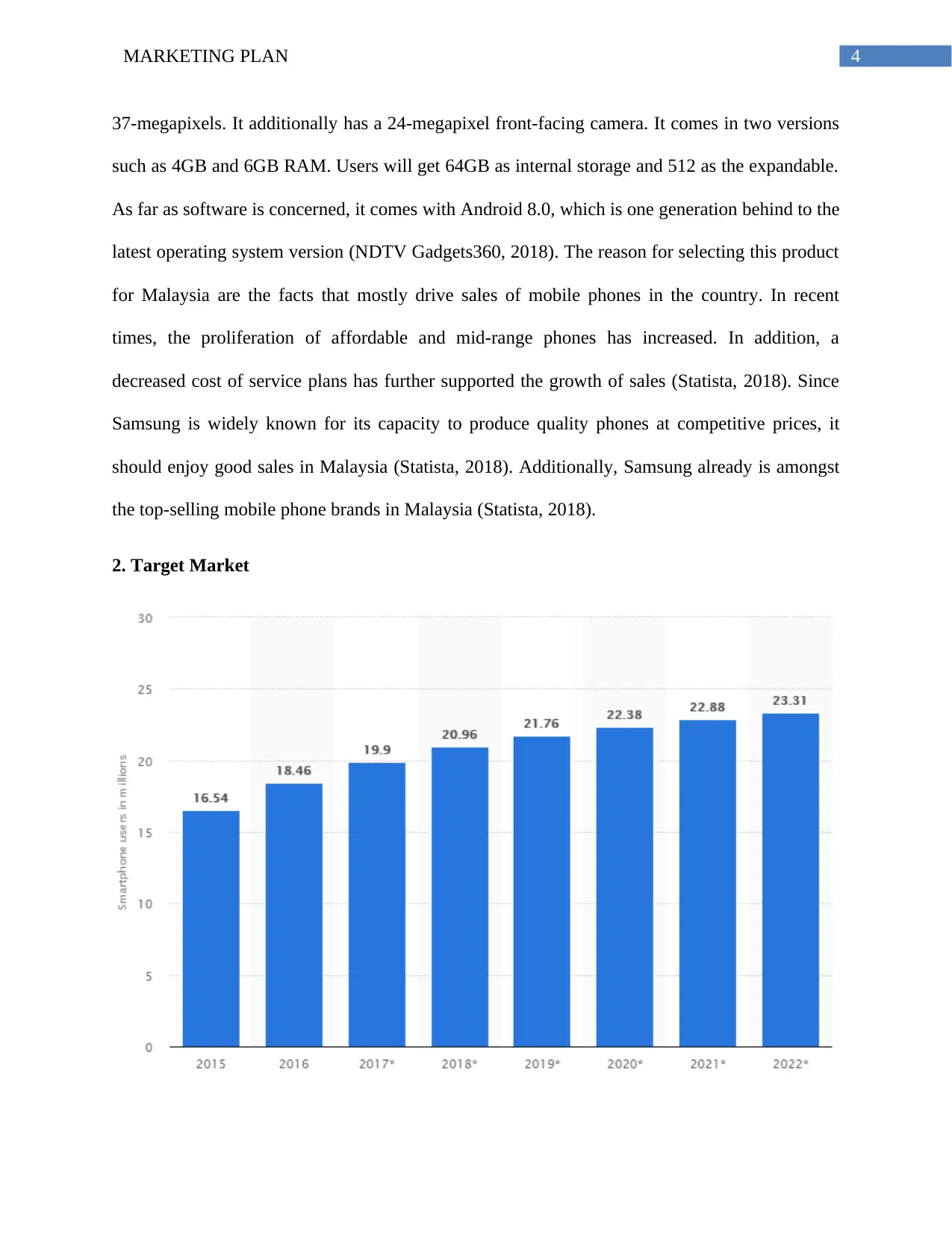
4MARKETING PLAN
37-megapixels. It additionally has a 24-megapixel front-facing camera. It comes in two versions
such as 4GB and 6GB RAM. Users will get 64GB as internal storage and 512 as the expandable.
As far as software is concerned, it comes with Android 8.0, which is one generation behind to the
latest operating system version (NDTV Gadgets360, 2018). The reason for selecting this product
for Malaysia are the facts that mostly drive sales of mobile phones in the country. In recent
times, the proliferation of affordable and mid-range phones has increased. In addition, a
decreased cost of service plans has further supported the growth of sales (Statista, 2018). Since
Samsung is widely known for its capacity to produce quality phones at competitive prices, it
should enjoy good sales in Malaysia (Statista, 2018). Additionally, Samsung already is amongst
the top-selling mobile phone brands in Malaysia (Statista, 2018).
2. Target Market
37-megapixels. It additionally has a 24-megapixel front-facing camera. It comes in two versions
such as 4GB and 6GB RAM. Users will get 64GB as internal storage and 512 as the expandable.
As far as software is concerned, it comes with Android 8.0, which is one generation behind to the
latest operating system version (NDTV Gadgets360, 2018). The reason for selecting this product
for Malaysia are the facts that mostly drive sales of mobile phones in the country. In recent
times, the proliferation of affordable and mid-range phones has increased. In addition, a
decreased cost of service plans has further supported the growth of sales (Statista, 2018). Since
Samsung is widely known for its capacity to produce quality phones at competitive prices, it
should enjoy good sales in Malaysia (Statista, 2018). Additionally, Samsung already is amongst
the top-selling mobile phone brands in Malaysia (Statista, 2018).
2. Target Market
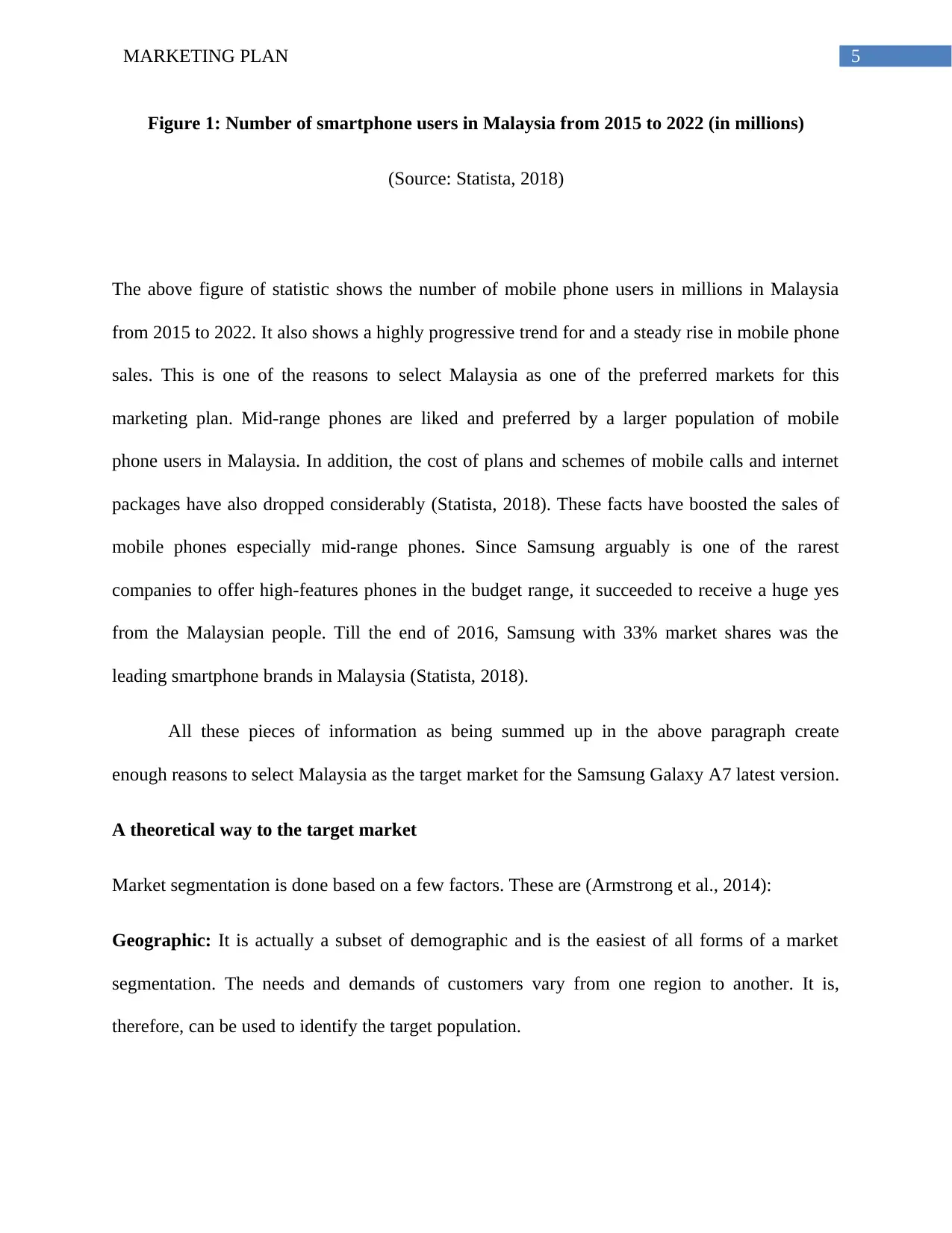
5MARKETING PLAN
Figure 1: Number of smartphone users in Malaysia from 2015 to 2022 (in millions)
(Source: Statista, 2018)
The above figure of statistic shows the number of mobile phone users in millions in Malaysia
from 2015 to 2022. It also shows a highly progressive trend for and a steady rise in mobile phone
sales. This is one of the reasons to select Malaysia as one of the preferred markets for this
marketing plan. Mid-range phones are liked and preferred by a larger population of mobile
phone users in Malaysia. In addition, the cost of plans and schemes of mobile calls and internet
packages have also dropped considerably (Statista, 2018). These facts have boosted the sales of
mobile phones especially mid-range phones. Since Samsung arguably is one of the rarest
companies to offer high-features phones in the budget range, it succeeded to receive a huge yes
from the Malaysian people. Till the end of 2016, Samsung with 33% market shares was the
leading smartphone brands in Malaysia (Statista, 2018).
All these pieces of information as being summed up in the above paragraph create
enough reasons to select Malaysia as the target market for the Samsung Galaxy A7 latest version.
A theoretical way to the target market
Market segmentation is done based on a few factors. These are (Armstrong et al., 2014):
Geographic: It is actually a subset of demographic and is the easiest of all forms of a market
segmentation. The needs and demands of customers vary from one region to another. It is,
therefore, can be used to identify the target population.
Figure 1: Number of smartphone users in Malaysia from 2015 to 2022 (in millions)
(Source: Statista, 2018)
The above figure of statistic shows the number of mobile phone users in millions in Malaysia
from 2015 to 2022. It also shows a highly progressive trend for and a steady rise in mobile phone
sales. This is one of the reasons to select Malaysia as one of the preferred markets for this
marketing plan. Mid-range phones are liked and preferred by a larger population of mobile
phone users in Malaysia. In addition, the cost of plans and schemes of mobile calls and internet
packages have also dropped considerably (Statista, 2018). These facts have boosted the sales of
mobile phones especially mid-range phones. Since Samsung arguably is one of the rarest
companies to offer high-features phones in the budget range, it succeeded to receive a huge yes
from the Malaysian people. Till the end of 2016, Samsung with 33% market shares was the
leading smartphone brands in Malaysia (Statista, 2018).
All these pieces of information as being summed up in the above paragraph create
enough reasons to select Malaysia as the target market for the Samsung Galaxy A7 latest version.
A theoretical way to the target market
Market segmentation is done based on a few factors. These are (Armstrong et al., 2014):
Geographic: It is actually a subset of demographic and is the easiest of all forms of a market
segmentation. The needs and demands of customers vary from one region to another. It is,
therefore, can be used to identify the target population.
⊘ This is a preview!⊘
Do you want full access?
Subscribe today to unlock all pages.

Trusted by 1+ million students worldwide
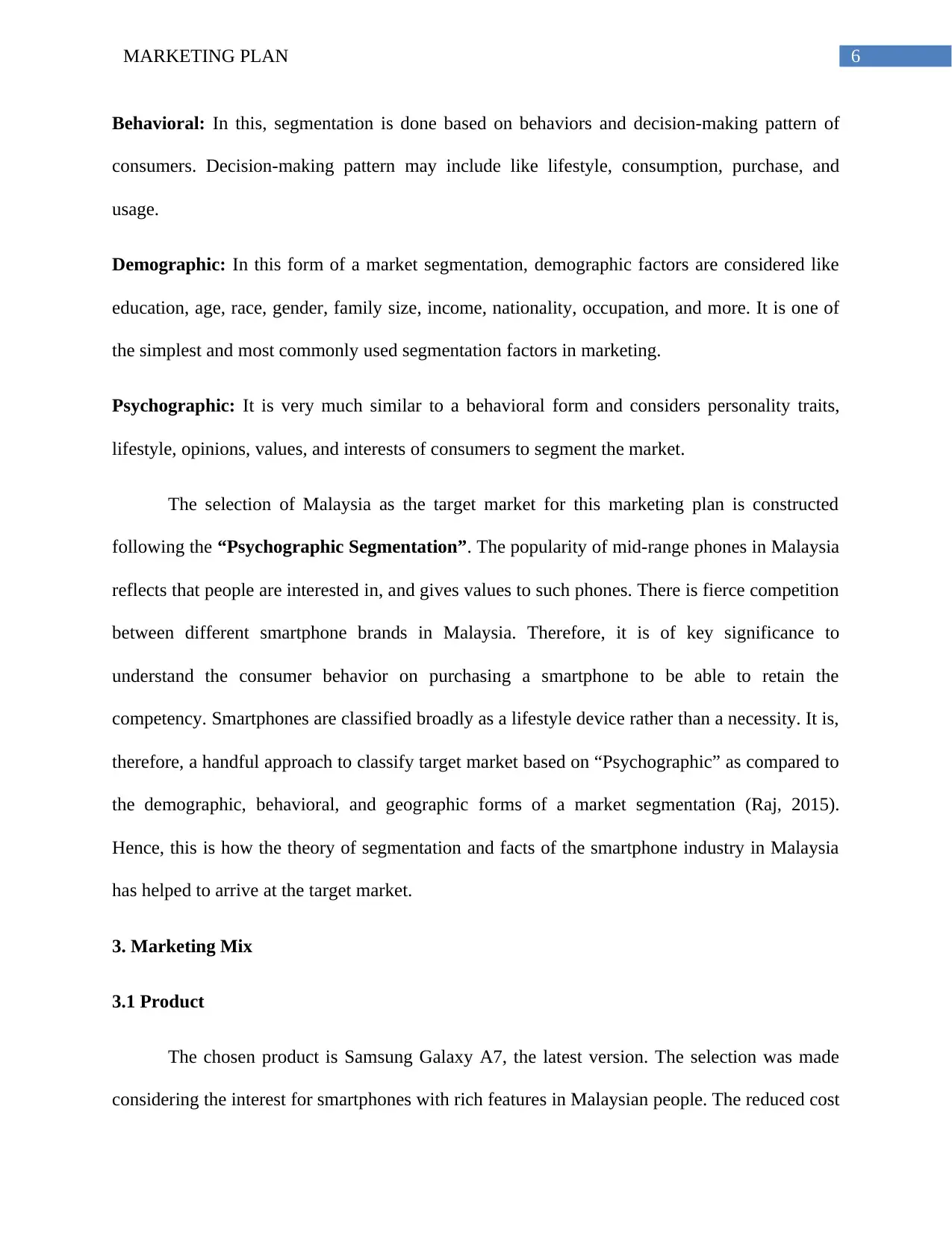
6MARKETING PLAN
Behavioral: In this, segmentation is done based on behaviors and decision-making pattern of
consumers. Decision-making pattern may include like lifestyle, consumption, purchase, and
usage.
Demographic: In this form of a market segmentation, demographic factors are considered like
education, age, race, gender, family size, income, nationality, occupation, and more. It is one of
the simplest and most commonly used segmentation factors in marketing.
Psychographic: It is very much similar to a behavioral form and considers personality traits,
lifestyle, opinions, values, and interests of consumers to segment the market.
The selection of Malaysia as the target market for this marketing plan is constructed
following the “Psychographic Segmentation”. The popularity of mid-range phones in Malaysia
reflects that people are interested in, and gives values to such phones. There is fierce competition
between different smartphone brands in Malaysia. Therefore, it is of key significance to
understand the consumer behavior on purchasing a smartphone to be able to retain the
competency. Smartphones are classified broadly as a lifestyle device rather than a necessity. It is,
therefore, a handful approach to classify target market based on “Psychographic” as compared to
the demographic, behavioral, and geographic forms of a market segmentation (Raj, 2015).
Hence, this is how the theory of segmentation and facts of the smartphone industry in Malaysia
has helped to arrive at the target market.
3. Marketing Mix
3.1 Product
The chosen product is Samsung Galaxy A7, the latest version. The selection was made
considering the interest for smartphones with rich features in Malaysian people. The reduced cost
Behavioral: In this, segmentation is done based on behaviors and decision-making pattern of
consumers. Decision-making pattern may include like lifestyle, consumption, purchase, and
usage.
Demographic: In this form of a market segmentation, demographic factors are considered like
education, age, race, gender, family size, income, nationality, occupation, and more. It is one of
the simplest and most commonly used segmentation factors in marketing.
Psychographic: It is very much similar to a behavioral form and considers personality traits,
lifestyle, opinions, values, and interests of consumers to segment the market.
The selection of Malaysia as the target market for this marketing plan is constructed
following the “Psychographic Segmentation”. The popularity of mid-range phones in Malaysia
reflects that people are interested in, and gives values to such phones. There is fierce competition
between different smartphone brands in Malaysia. Therefore, it is of key significance to
understand the consumer behavior on purchasing a smartphone to be able to retain the
competency. Smartphones are classified broadly as a lifestyle device rather than a necessity. It is,
therefore, a handful approach to classify target market based on “Psychographic” as compared to
the demographic, behavioral, and geographic forms of a market segmentation (Raj, 2015).
Hence, this is how the theory of segmentation and facts of the smartphone industry in Malaysia
has helped to arrive at the target market.
3. Marketing Mix
3.1 Product
The chosen product is Samsung Galaxy A7, the latest version. The selection was made
considering the interest for smartphones with rich features in Malaysian people. The reduced cost
Paraphrase This Document
Need a fresh take? Get an instant paraphrase of this document with our AI Paraphraser
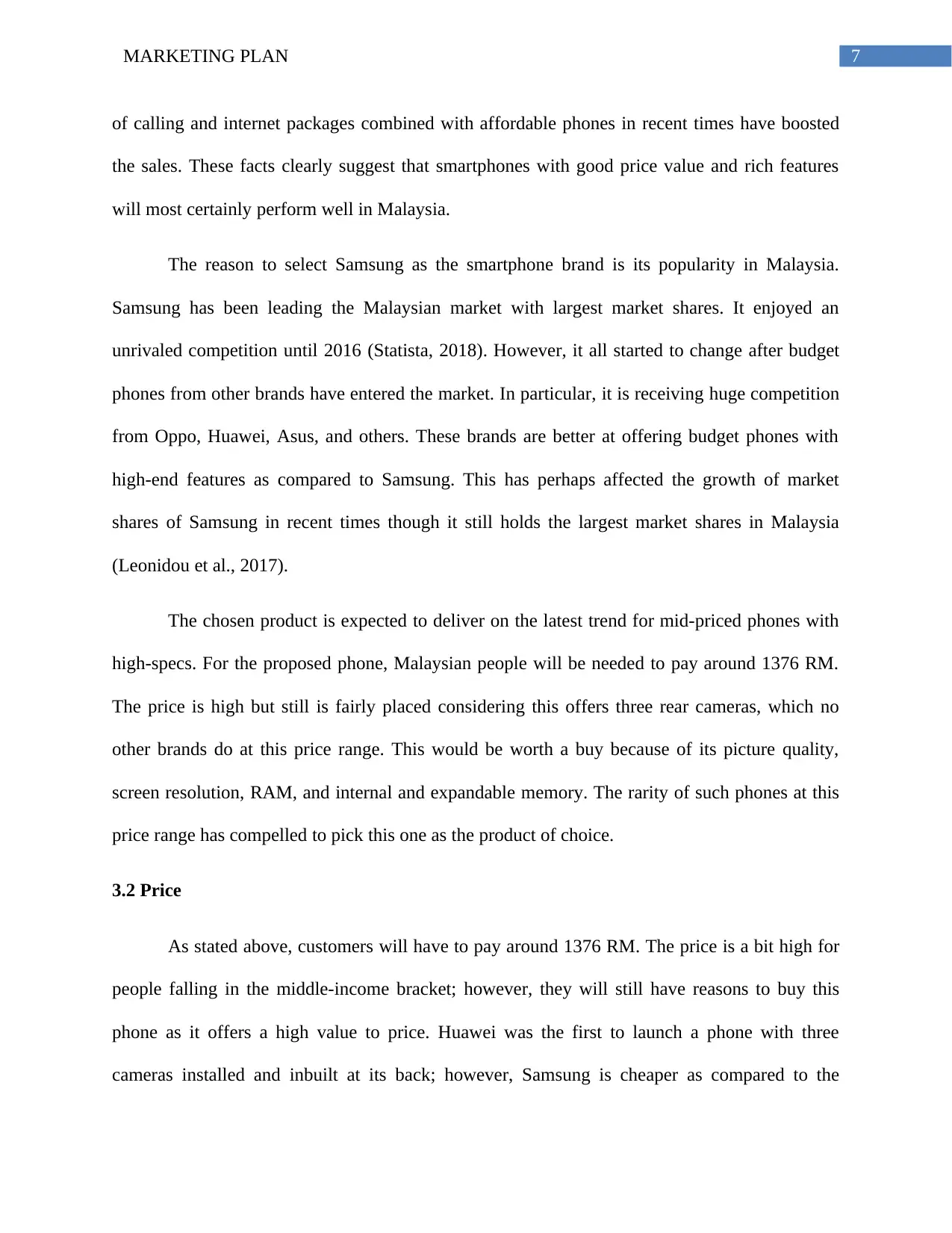
7MARKETING PLAN
of calling and internet packages combined with affordable phones in recent times have boosted
the sales. These facts clearly suggest that smartphones with good price value and rich features
will most certainly perform well in Malaysia.
The reason to select Samsung as the smartphone brand is its popularity in Malaysia.
Samsung has been leading the Malaysian market with largest market shares. It enjoyed an
unrivaled competition until 2016 (Statista, 2018). However, it all started to change after budget
phones from other brands have entered the market. In particular, it is receiving huge competition
from Oppo, Huawei, Asus, and others. These brands are better at offering budget phones with
high-end features as compared to Samsung. This has perhaps affected the growth of market
shares of Samsung in recent times though it still holds the largest market shares in Malaysia
(Leonidou et al., 2017).
The chosen product is expected to deliver on the latest trend for mid-priced phones with
high-specs. For the proposed phone, Malaysian people will be needed to pay around 1376 RM.
The price is high but still is fairly placed considering this offers three rear cameras, which no
other brands do at this price range. This would be worth a buy because of its picture quality,
screen resolution, RAM, and internal and expandable memory. The rarity of such phones at this
price range has compelled to pick this one as the product of choice.
3.2 Price
As stated above, customers will have to pay around 1376 RM. The price is a bit high for
people falling in the middle-income bracket; however, they will still have reasons to buy this
phone as it offers a high value to price. Huawei was the first to launch a phone with three
cameras installed and inbuilt at its back; however, Samsung is cheaper as compared to the
of calling and internet packages combined with affordable phones in recent times have boosted
the sales. These facts clearly suggest that smartphones with good price value and rich features
will most certainly perform well in Malaysia.
The reason to select Samsung as the smartphone brand is its popularity in Malaysia.
Samsung has been leading the Malaysian market with largest market shares. It enjoyed an
unrivaled competition until 2016 (Statista, 2018). However, it all started to change after budget
phones from other brands have entered the market. In particular, it is receiving huge competition
from Oppo, Huawei, Asus, and others. These brands are better at offering budget phones with
high-end features as compared to Samsung. This has perhaps affected the growth of market
shares of Samsung in recent times though it still holds the largest market shares in Malaysia
(Leonidou et al., 2017).
The chosen product is expected to deliver on the latest trend for mid-priced phones with
high-specs. For the proposed phone, Malaysian people will be needed to pay around 1376 RM.
The price is high but still is fairly placed considering this offers three rear cameras, which no
other brands do at this price range. This would be worth a buy because of its picture quality,
screen resolution, RAM, and internal and expandable memory. The rarity of such phones at this
price range has compelled to pick this one as the product of choice.
3.2 Price
As stated above, customers will have to pay around 1376 RM. The price is a bit high for
people falling in the middle-income bracket; however, they will still have reasons to buy this
phone as it offers a high value to price. Huawei was the first to launch a phone with three
cameras installed and inbuilt at its back; however, Samsung is cheaper as compared to the
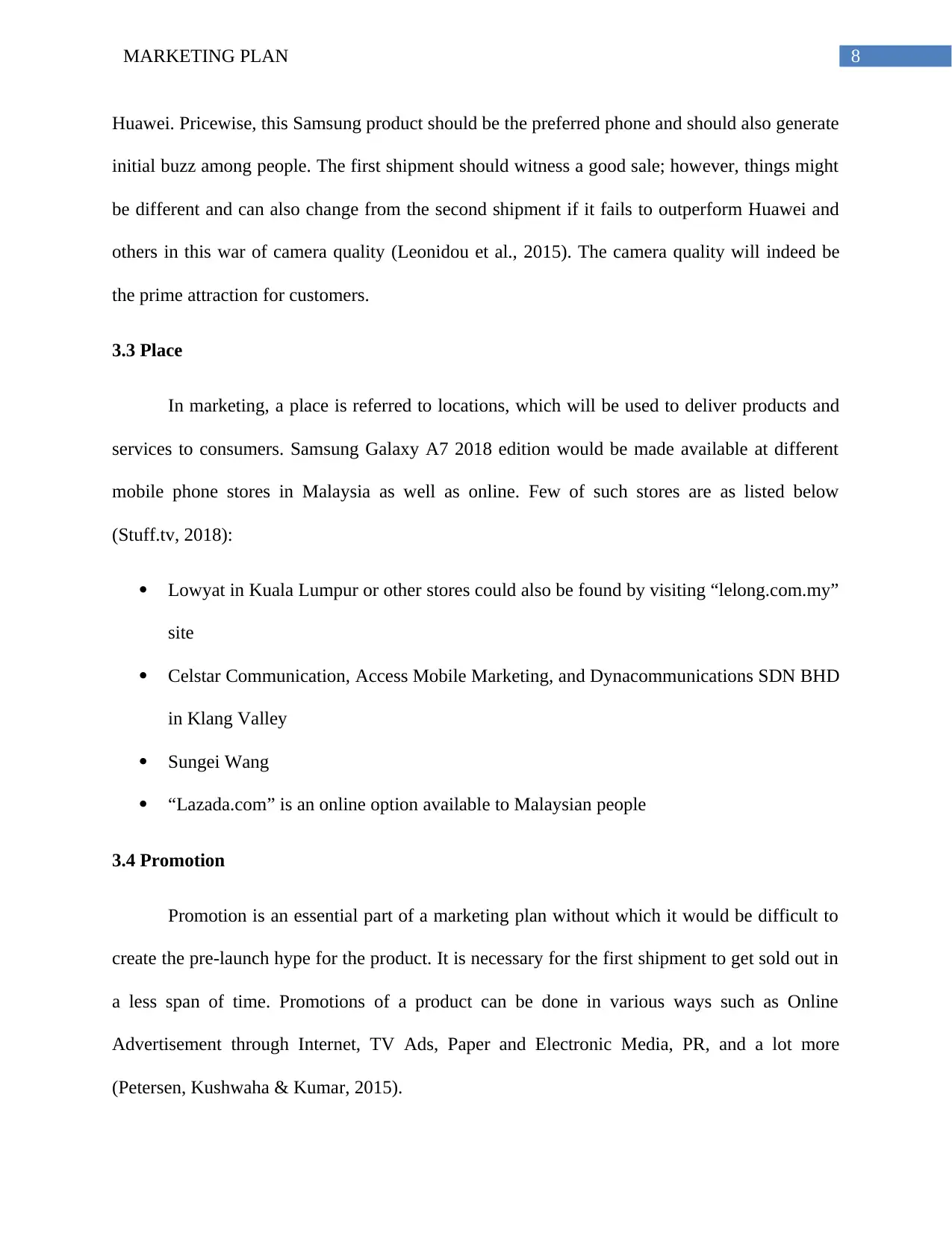
8MARKETING PLAN
Huawei. Pricewise, this Samsung product should be the preferred phone and should also generate
initial buzz among people. The first shipment should witness a good sale; however, things might
be different and can also change from the second shipment if it fails to outperform Huawei and
others in this war of camera quality (Leonidou et al., 2015). The camera quality will indeed be
the prime attraction for customers.
3.3 Place
In marketing, a place is referred to locations, which will be used to deliver products and
services to consumers. Samsung Galaxy A7 2018 edition would be made available at different
mobile phone stores in Malaysia as well as online. Few of such stores are as listed below
(Stuff.tv, 2018):
Lowyat in Kuala Lumpur or other stores could also be found by visiting “lelong.com.my”
site
Celstar Communication, Access Mobile Marketing, and Dynacommunications SDN BHD
in Klang Valley
Sungei Wang
“Lazada.com” is an online option available to Malaysian people
3.4 Promotion
Promotion is an essential part of a marketing plan without which it would be difficult to
create the pre-launch hype for the product. It is necessary for the first shipment to get sold out in
a less span of time. Promotions of a product can be done in various ways such as Online
Advertisement through Internet, TV Ads, Paper and Electronic Media, PR, and a lot more
(Petersen, Kushwaha & Kumar, 2015).
Huawei. Pricewise, this Samsung product should be the preferred phone and should also generate
initial buzz among people. The first shipment should witness a good sale; however, things might
be different and can also change from the second shipment if it fails to outperform Huawei and
others in this war of camera quality (Leonidou et al., 2015). The camera quality will indeed be
the prime attraction for customers.
3.3 Place
In marketing, a place is referred to locations, which will be used to deliver products and
services to consumers. Samsung Galaxy A7 2018 edition would be made available at different
mobile phone stores in Malaysia as well as online. Few of such stores are as listed below
(Stuff.tv, 2018):
Lowyat in Kuala Lumpur or other stores could also be found by visiting “lelong.com.my”
site
Celstar Communication, Access Mobile Marketing, and Dynacommunications SDN BHD
in Klang Valley
Sungei Wang
“Lazada.com” is an online option available to Malaysian people
3.4 Promotion
Promotion is an essential part of a marketing plan without which it would be difficult to
create the pre-launch hype for the product. It is necessary for the first shipment to get sold out in
a less span of time. Promotions of a product can be done in various ways such as Online
Advertisement through Internet, TV Ads, Paper and Electronic Media, PR, and a lot more
(Petersen, Kushwaha & Kumar, 2015).
⊘ This is a preview!⊘
Do you want full access?
Subscribe today to unlock all pages.

Trusted by 1+ million students worldwide
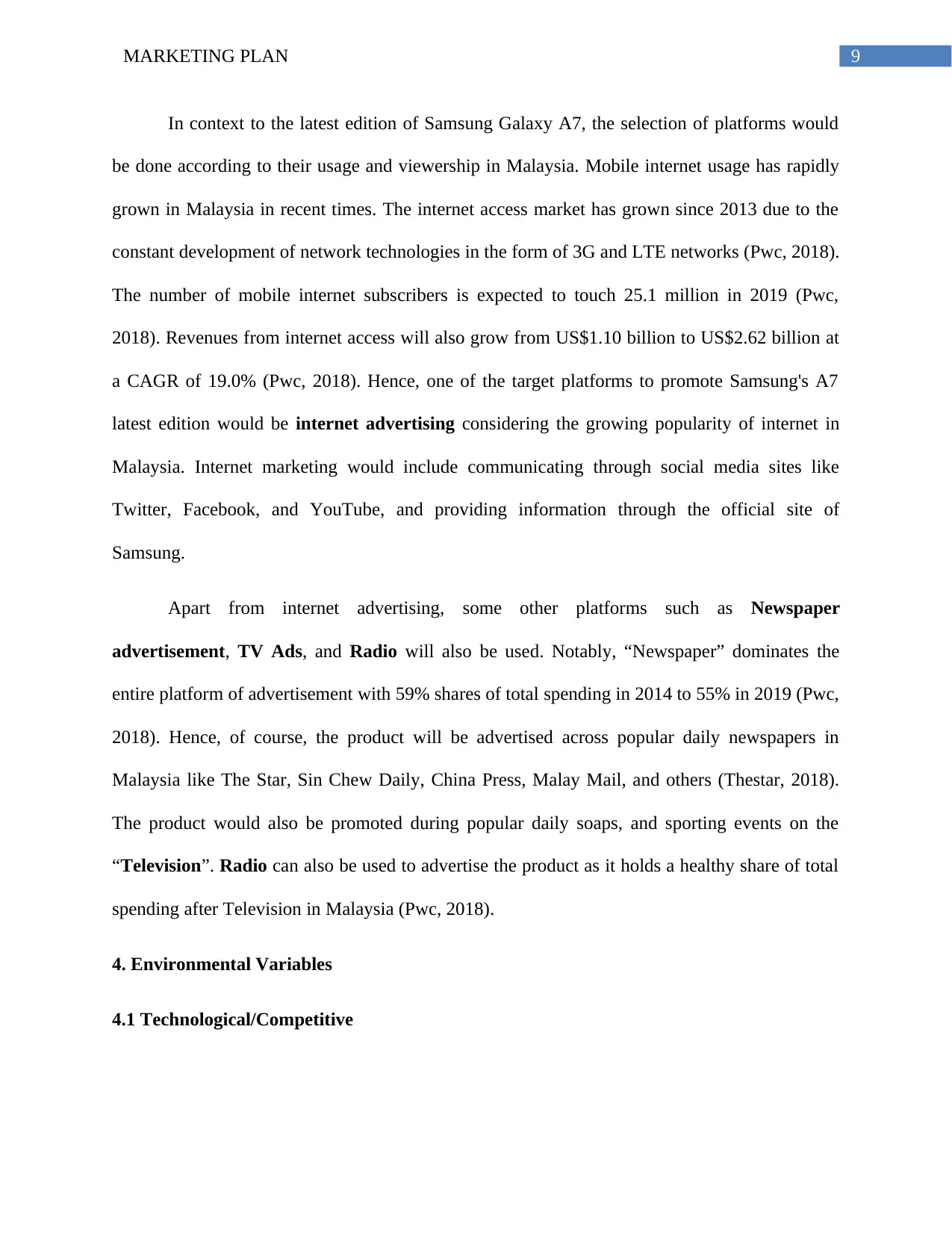
9MARKETING PLAN
In context to the latest edition of Samsung Galaxy A7, the selection of platforms would
be done according to their usage and viewership in Malaysia. Mobile internet usage has rapidly
grown in Malaysia in recent times. The internet access market has grown since 2013 due to the
constant development of network technologies in the form of 3G and LTE networks (Pwc, 2018).
The number of mobile internet subscribers is expected to touch 25.1 million in 2019 (Pwc,
2018). Revenues from internet access will also grow from US$1.10 billion to US$2.62 billion at
a CAGR of 19.0% (Pwc, 2018). Hence, one of the target platforms to promote Samsung's A7
latest edition would be internet advertising considering the growing popularity of internet in
Malaysia. Internet marketing would include communicating through social media sites like
Twitter, Facebook, and YouTube, and providing information through the official site of
Samsung.
Apart from internet advertising, some other platforms such as Newspaper
advertisement, TV Ads, and Radio will also be used. Notably, “Newspaper” dominates the
entire platform of advertisement with 59% shares of total spending in 2014 to 55% in 2019 (Pwc,
2018). Hence, of course, the product will be advertised across popular daily newspapers in
Malaysia like The Star, Sin Chew Daily, China Press, Malay Mail, and others (Thestar, 2018).
The product would also be promoted during popular daily soaps, and sporting events on the
“Television”. Radio can also be used to advertise the product as it holds a healthy share of total
spending after Television in Malaysia (Pwc, 2018).
4. Environmental Variables
4.1 Technological/Competitive
In context to the latest edition of Samsung Galaxy A7, the selection of platforms would
be done according to their usage and viewership in Malaysia. Mobile internet usage has rapidly
grown in Malaysia in recent times. The internet access market has grown since 2013 due to the
constant development of network technologies in the form of 3G and LTE networks (Pwc, 2018).
The number of mobile internet subscribers is expected to touch 25.1 million in 2019 (Pwc,
2018). Revenues from internet access will also grow from US$1.10 billion to US$2.62 billion at
a CAGR of 19.0% (Pwc, 2018). Hence, one of the target platforms to promote Samsung's A7
latest edition would be internet advertising considering the growing popularity of internet in
Malaysia. Internet marketing would include communicating through social media sites like
Twitter, Facebook, and YouTube, and providing information through the official site of
Samsung.
Apart from internet advertising, some other platforms such as Newspaper
advertisement, TV Ads, and Radio will also be used. Notably, “Newspaper” dominates the
entire platform of advertisement with 59% shares of total spending in 2014 to 55% in 2019 (Pwc,
2018). Hence, of course, the product will be advertised across popular daily newspapers in
Malaysia like The Star, Sin Chew Daily, China Press, Malay Mail, and others (Thestar, 2018).
The product would also be promoted during popular daily soaps, and sporting events on the
“Television”. Radio can also be used to advertise the product as it holds a healthy share of total
spending after Television in Malaysia (Pwc, 2018).
4. Environmental Variables
4.1 Technological/Competitive
Paraphrase This Document
Need a fresh take? Get an instant paraphrase of this document with our AI Paraphraser
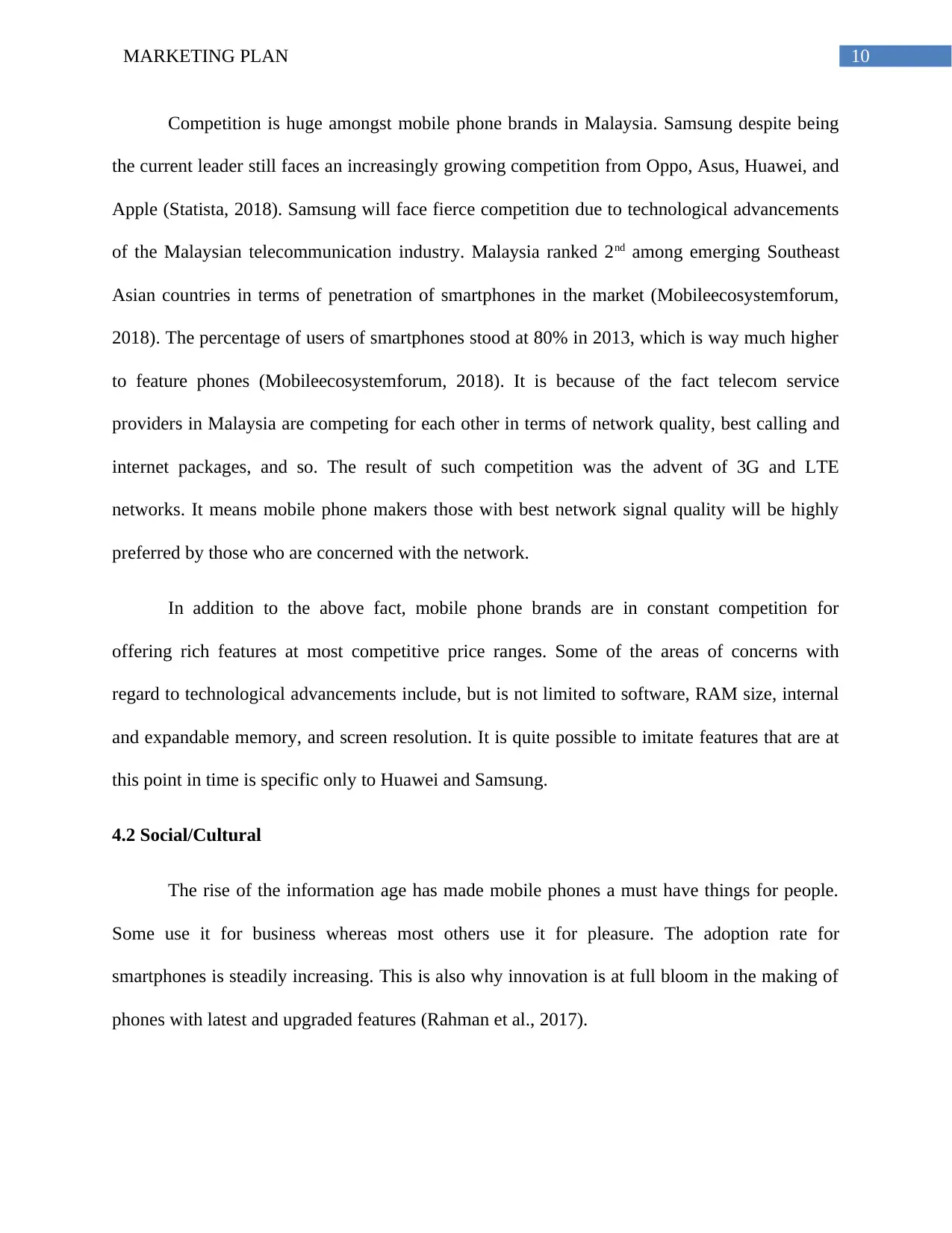
10MARKETING PLAN
Competition is huge amongst mobile phone brands in Malaysia. Samsung despite being
the current leader still faces an increasingly growing competition from Oppo, Asus, Huawei, and
Apple (Statista, 2018). Samsung will face fierce competition due to technological advancements
of the Malaysian telecommunication industry. Malaysia ranked 2nd among emerging Southeast
Asian countries in terms of penetration of smartphones in the market (Mobileecosystemforum,
2018). The percentage of users of smartphones stood at 80% in 2013, which is way much higher
to feature phones (Mobileecosystemforum, 2018). It is because of the fact telecom service
providers in Malaysia are competing for each other in terms of network quality, best calling and
internet packages, and so. The result of such competition was the advent of 3G and LTE
networks. It means mobile phone makers those with best network signal quality will be highly
preferred by those who are concerned with the network.
In addition to the above fact, mobile phone brands are in constant competition for
offering rich features at most competitive price ranges. Some of the areas of concerns with
regard to technological advancements include, but is not limited to software, RAM size, internal
and expandable memory, and screen resolution. It is quite possible to imitate features that are at
this point in time is specific only to Huawei and Samsung.
4.2 Social/Cultural
The rise of the information age has made mobile phones a must have things for people.
Some use it for business whereas most others use it for pleasure. The adoption rate for
smartphones is steadily increasing. This is also why innovation is at full bloom in the making of
phones with latest and upgraded features (Rahman et al., 2017).
Competition is huge amongst mobile phone brands in Malaysia. Samsung despite being
the current leader still faces an increasingly growing competition from Oppo, Asus, Huawei, and
Apple (Statista, 2018). Samsung will face fierce competition due to technological advancements
of the Malaysian telecommunication industry. Malaysia ranked 2nd among emerging Southeast
Asian countries in terms of penetration of smartphones in the market (Mobileecosystemforum,
2018). The percentage of users of smartphones stood at 80% in 2013, which is way much higher
to feature phones (Mobileecosystemforum, 2018). It is because of the fact telecom service
providers in Malaysia are competing for each other in terms of network quality, best calling and
internet packages, and so. The result of such competition was the advent of 3G and LTE
networks. It means mobile phone makers those with best network signal quality will be highly
preferred by those who are concerned with the network.
In addition to the above fact, mobile phone brands are in constant competition for
offering rich features at most competitive price ranges. Some of the areas of concerns with
regard to technological advancements include, but is not limited to software, RAM size, internal
and expandable memory, and screen resolution. It is quite possible to imitate features that are at
this point in time is specific only to Huawei and Samsung.
4.2 Social/Cultural
The rise of the information age has made mobile phones a must have things for people.
Some use it for business whereas most others use it for pleasure. The adoption rate for
smartphones is steadily increasing. This is also why innovation is at full bloom in the making of
phones with latest and upgraded features (Rahman et al., 2017).
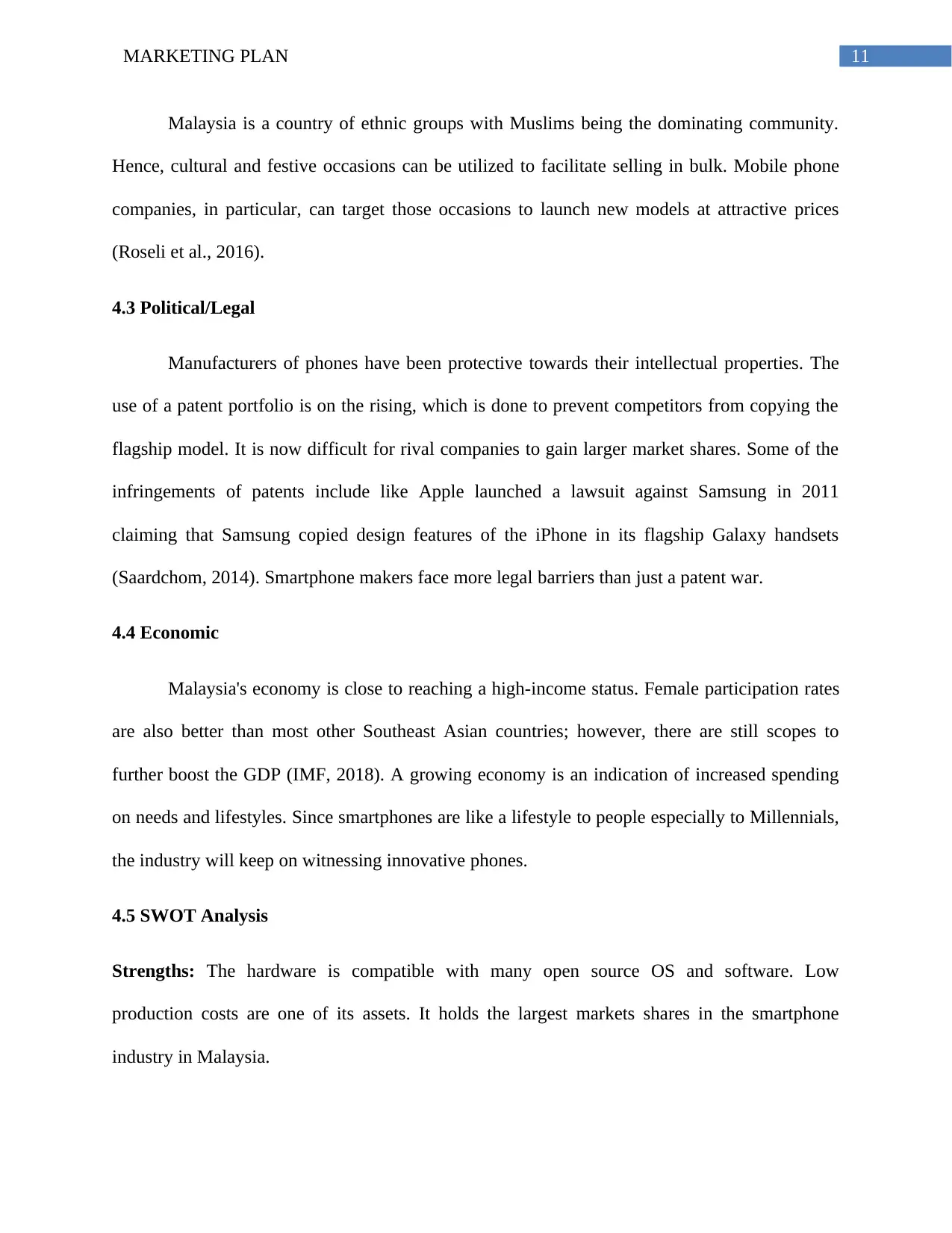
11MARKETING PLAN
Malaysia is a country of ethnic groups with Muslims being the dominating community.
Hence, cultural and festive occasions can be utilized to facilitate selling in bulk. Mobile phone
companies, in particular, can target those occasions to launch new models at attractive prices
(Roseli et al., 2016).
4.3 Political/Legal
Manufacturers of phones have been protective towards their intellectual properties. The
use of a patent portfolio is on the rising, which is done to prevent competitors from copying the
flagship model. It is now difficult for rival companies to gain larger market shares. Some of the
infringements of patents include like Apple launched a lawsuit against Samsung in 2011
claiming that Samsung copied design features of the iPhone in its flagship Galaxy handsets
(Saardchom, 2014). Smartphone makers face more legal barriers than just a patent war.
4.4 Economic
Malaysia's economy is close to reaching a high-income status. Female participation rates
are also better than most other Southeast Asian countries; however, there are still scopes to
further boost the GDP (IMF, 2018). A growing economy is an indication of increased spending
on needs and lifestyles. Since smartphones are like a lifestyle to people especially to Millennials,
the industry will keep on witnessing innovative phones.
4.5 SWOT Analysis
Strengths: The hardware is compatible with many open source OS and software. Low
production costs are one of its assets. It holds the largest markets shares in the smartphone
industry in Malaysia.
Malaysia is a country of ethnic groups with Muslims being the dominating community.
Hence, cultural and festive occasions can be utilized to facilitate selling in bulk. Mobile phone
companies, in particular, can target those occasions to launch new models at attractive prices
(Roseli et al., 2016).
4.3 Political/Legal
Manufacturers of phones have been protective towards their intellectual properties. The
use of a patent portfolio is on the rising, which is done to prevent competitors from copying the
flagship model. It is now difficult for rival companies to gain larger market shares. Some of the
infringements of patents include like Apple launched a lawsuit against Samsung in 2011
claiming that Samsung copied design features of the iPhone in its flagship Galaxy handsets
(Saardchom, 2014). Smartphone makers face more legal barriers than just a patent war.
4.4 Economic
Malaysia's economy is close to reaching a high-income status. Female participation rates
are also better than most other Southeast Asian countries; however, there are still scopes to
further boost the GDP (IMF, 2018). A growing economy is an indication of increased spending
on needs and lifestyles. Since smartphones are like a lifestyle to people especially to Millennials,
the industry will keep on witnessing innovative phones.
4.5 SWOT Analysis
Strengths: The hardware is compatible with many open source OS and software. Low
production costs are one of its assets. It holds the largest markets shares in the smartphone
industry in Malaysia.
⊘ This is a preview!⊘
Do you want full access?
Subscribe today to unlock all pages.

Trusted by 1+ million students worldwide
1 out of 17
Related Documents
Your All-in-One AI-Powered Toolkit for Academic Success.
+13062052269
info@desklib.com
Available 24*7 on WhatsApp / Email
![[object Object]](/_next/static/media/star-bottom.7253800d.svg)
Unlock your academic potential
Copyright © 2020–2025 A2Z Services. All Rights Reserved. Developed and managed by ZUCOL.





